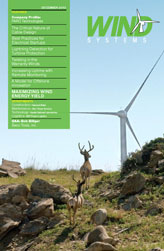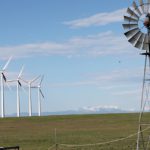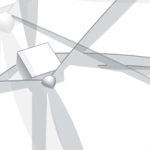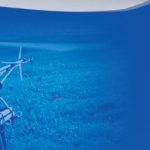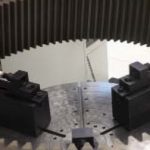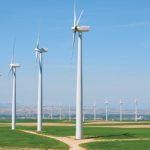Much like the gold rush or even the space race, the goal set by the U.S. government to reach 20 percent of energy coming from wind power by 2030 has sent everyone searching for ways to get involved. A report by AWEA [1] finds that, during the decade preceding 2030, the U.S. wind industry could:
• Support roughly 500,000 jobs in the U.S., with an annual average of more than 150,000 workers directly employed by the wind industry;
• Support more than 100,000 jobs in associated industries (e.g., accountants, lawyers, steel workers, and electrical manufacturing);
• Support more than 200,000 jobs through economic expansion based on local spending;
• Increase annual property tax revenues to more than $1.5 billion by 2030, and;
• Increase annual payments to rural landowners to more than $600 million in 2030.
The biggest deterrent is that harnessing the wind is a challenge, to say the least. Installing literally tons of equipment atop a tower hundreds of feet in the air? Building a machine that can handle exposure to permanently changing loads? Climbing into the clouds to maintain the turbine in extreme weather conditions? Sure, there are those who thrive on such challenges, but new remote condition monitoring equipment and service options lower the risks involved in maintaining your investment in wind power.
The two primary factors, each with a direct correlation to project profitability, are efficiency (how well a turbine performs when it’s operating) and availability (the time a turbine is available for production). Turbine size is permanently growing, and downtime can potentially cost project owners significant revenue. By simply considering the costs associated with an unanticipated gearbox failure during peak hours at a 3 MW turbine that is five miles offshore, the advantage of having prevented such a failure becomes abundantly clear.
Having monitored more than 1,000 turbines—different sizes from 250 kW to 5 MW and more than 20 different designs, onshore as well as offshore—we know that approximately 10 percent of all turbines will experience major damage each year (Figure 1). This might seem like an insignificant number when operating only a few turbines, and you may just fall into the category of the 90 percent of “lucky” owners who do not experience damages (Figure 2). But the average wind farm in North America has between 50 and 100 turbines, and the more turbines the more relevant those statistics become. Do you want to test your luck and be unprepared to halt the use of a turbine for a repair, or would you rather catch a small glitch before it snowballs into a huge problem?
Having a tool that helps asset managers to permanently monitor the condition of major components—the main bearing, gearbox, and generator—provides the basis for the right and timely decision. This lowers the probability of a major mechanical malfunction and betters your chances for profitable margins.
The main goals of remote condition monitoring are avoiding or prolonging the replacement of costly components, reducing high maintenance costs, optimizing utilization of recourses (equipment, personnel), limiting collateral damage, and reducing inventory costs and unscheduled downtime. A typical remote monitoring system will cost you approximately $10,000.
Since the gearbox seems to be the weakest element in the drivetrain, here is an example for cost savings by implementing condition monitoring: With no condition monitoring implemented gearbox damage occurs without warning, running to approximately $130,000 for replacement costs, and four to eight weeks of downtime. With condition monitoring in place indicators for gearbox damage is detected early, maintenance can be scheduled around the wind, it will cost approximately $70,000 for repair/overhaul, and one or two weeks of downtime.
Another potential for cost savings involves the “end of warranty inspection.” It is common practice to perform a 100-percent visual inspection of all gearboxes—100 percent with regard to the number of gearboxes is correct, but 100 percent with regard to the components of the gearboxes unfortunately is not. Many components remain uninspected. With a remote condition monitoring system in place you could focus the inspection on those gearboxes showing certain indicators for wear/damage and perform a more-thorough inspection. Figure 3
Condition monitoring is not new. It is standard practice for steam turbines, gas turbines, and even hydro turbines. However, remote conditioning for wind turbines faces very unique challenges such as the very low speed of the rotor (main bearing) rotation and the permanently changing dynamic loads. “Standard” condition monitoring systems would create either tons of false alarms or no alarm at all, both of which are absolutely critical for the acceptance of a condition monitoring system.
In the early nineties Schenck and ISET (today Fraunhofer-IWES) started a project sponsored by the German government to develop technology for monitoring the condition of wind turbines. The result was the product “VIBRO-IC,” the first dedicated, industrial-proven monitor for wind turbines. It was monitoring rotor unbalance, aerodynamic unbalance, misalignment, and bearing, gear, and generator condition. VIBRO-IC got an award for “best new product of the year 1998” by Design News magazine.
In 2003 Schenck Trebel partnered with Prasentia, a system integrator and service provider to the wind power industry, to develop remote interface capability between the condition monitoring system and the SCADA system. A cooperative pilot study of the installation began at a wind farm in Palm Springs, California, that utilized 700 kW turbines. Within a short time a potential misalignment problem between the generator and the gearbox was detected by the CMS. The alignment check revealed that the misalignment was greater than the acceptable tolerance. A second observation showed high “shock pulse readings”—an indicator for bearing problems—on the NDE side of the generator. During a scheduled maintenance the lubrication system was checked and adjusted. The shock pulse readings went back to “normal” [2].
Allianz, one of the largest insurance companies in Germany, conducted vast research in condition monitoring for wind turbines and summarized the results in their final report in 2003 [3]. The report describes the basic requirements for a CMS for wind turbines. It makes clear that only online systems with remote access for a “vibration expert” are acceptable for this application. The report refers to the final report from ISET from 1999.
It is essential for the acceptance of condition monitoring for wind turbines to combine a dedicated product with the experience of vibration experts. For these reasons Schenck is not offering a product to the industry, but rather the remote condition monitoring service. Both the product as well as the service are certified by GL Garrad Hassan and approved by Allianz.
Our service center (Figure 4) will monitors turbines 24/7, providing notification in case irregularities/indicators have been detected along with an explanation of measurements, trend curves, spectra, etc., and recommendations as to actions to be taken, and with what degree of urgency. To be able to provide the service we make sure that the right sensor is picked and installed properly in the right location, that the system is set up individually for your specific turbine, the communication works reliably, and the monitoring center is available at all times. Will your turbine be one of the 10 percent to experience damage, or will you be in the 90 percent who enjoy increased profitability? Remote condition monitoring could be the determining factor.
References:
1) www.20percentwind.org
2) Schenck balancing news 0406
3) Allianz Centre for Technology, report nr. 03.01.068



















